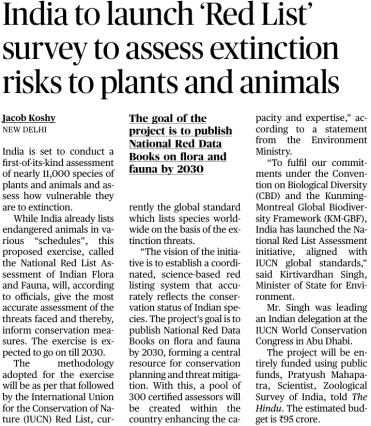Syllabus Mapping
GS Paper 2 – Social Justice and Governance
- Issues relating to development and management of social sector services (Health).
- Government policies and interventions for vulnerable sections.
- Welfare schemes for health and education.
- Role of NGOs and SHGs in health service delivery.
Context On October 10, the world observes World Mental Health Day, highlighting the growing crisis of mental illness worldwide. Over one billion people—about 13% of the global population—suffer from mental health issues.
In India, the situation is equally concerning, with a 13.7% lifetime prevalence of mental disorders and nearly 200 million individuals affected. Despite several initiatives, the country continues to face a fragmented and underfunded mental health system.
Legal Framework for Mental Health in India
1. Mental Healthcare Act, 2017
Recognises mental health as a fundamental right under Article 21 of the Constitution. o Guarantees the right to affordable and quality mental healthcare, insurance coverage, and patient dignity and autonomy. o Decriminalises suicide and binds the government legally to ensure adequate mental health infrastructure.
2. Judicial Reinforcement – Sukdeb Saha vs. State of Andhra Pradesh (2022)
The Supreme Court reaffirmed the right to mental health as a constitutional right, directing the State to provide accessible and quality services.
Government Initiatives for Mental Health 1. District Mental Health Programme (DMHP)
Operational across 767 districts, expanding access to counselling, outpatient services, and suicide prevention. o Represents an attempt to ecentralize mental health services and integrate care at the district level. 2. Tele-MANAS (Mental Health Assistance and Networking Across States)
A 24×7 national mental health helpline launched to ensure accessibility, especially in rural and underserved regions. o Has enabled over 20 lakh tele-counselling sessions, offering support for depression, anxiety, and stress.
3. Manodarpan Initiative o School-based government programme launched under the National Education Policy (NEP) framework. o Has reached over 11 crore students, promoting emotional well-being and early intervention among adolescents.
4. Manas App (Mental Health & Normalcy Augmentation System) o A mobile-based platform integrating health and wellness services with digital therapy and emotional resilience support.
Current Status and Challenges
1. Huge Treatment Gap o The National Mental Health Survey (2015–16) found treatment gaps of 70–92% across mental disorders. o Only 1.05% of India’s health budget is allocated to mental health — far below the WHO’s recommended 5%.
2. Severe Workforce Shortage o India has only 0.75 psychiatrists and 0.12 psychologists per 1,00,000 population, against the WHO’s requirement of 3 psychiatrists per 1,00,000.
3. Persistent Stigma and Lack of Awareness o Over 50% of Indians still attribute mental illness to personal weakness or shame, discouraging people from seeking help.
4. Fragmented Policy and Institutional Response o Mental health governance is split among multiple ministries—Health, Education, Social Justice, and Labour—causing coordination failures. o Rural areas, which constitute 70% of India’s population, face acute shortages of specialised facilities.
5. Data and Research Gaps o Mental health surveillance systems remain underdeveloped. o National data on mental illness prevalence and outcomes remain fragmented and inconsistent.
Global Comparisons
- Countries such as Australia, Canada, and the U.K. allocate 4–10% of their total health budget to mental health.
- These nations rely on mid-level counsellors and community-based care models, making mental health services more accessible and cost-effective.
Significance - Mental health directly affects economic productivity, with untreated mental illnesses causing losses exceeding $1 trillion annually by 2030.
- A unified, well-funded system would help achieve SDG 3 – Good Health and Well-being, promote inclusive human development, and ensure social justice.
UPSC Mains Q. Despite progressive legal frameworks like the Mental Healthcare Act, 2017, India’s mental health response remains fragmented and under-resourced. Discuss the challenges and suggest measures to create a unified, accessible, and rights-based mental health system in India.
Why we need to change the way we talk about antibiotic resistance
Syllabus Mapping GS Paper 3 – Science & Technology / Health

- Biotechnology and its applications in daily life
- Issues relating to health, hygiene, and communicable diseases
- Government policies for health sector
- Environmental pollution and sustainable management (One Health approach)
Context
Antimicrobial Resistance (AMR) — the ability of microbes such as bacteria, viruses, fungi, and parasites to resist the effects of medicines — has become one of the gravest global health challenges.
While scientific awareness of AMR has grown, public communication around it has failed to inspire sufficient behavioural and systemic change. The article argues that AMR is not only a
medical problem but also a
communication and social crisis that demands new narratives focused on human connection, biology, and responsibility.
Understanding AMR: The Indian Context
- The issue of AMR gained national attention in 2010, when researchers described an enzyme named New Delhi Metallo-beta-lactamase (NDM-1) that made many antibiotics ineffective.
- The revelation sparked political controversy but eventually led to policy measures such as the Chennai Declaration, a multi-stakeholder roadmap to combat AMR.
- Over the past decade, AMR has worsened despite international action plans, with WHO warning that by 2050, 10 million deaths annually could occur due to antibiotic resistance, pushing global healthcare systems to the brink.
The Present Challenge - India is among the largest consumers of antibiotics globally. Overuse and misuse in humans, livestock, and agriculture have accelerated resistance.
- Predictions and warnings—though scientifically sound—have lost impact due to repetition and lack of relatable communication.
- The focus must shift from projecting a distant catastrophe (2050) to explaining present-day effects on individuals:
- Recurrent infections
- Slower wound healing
- Increased hospital stays and treatment costs
- Everyday ailments like respiratory and skin infections becoming harder to treat
The article stresses the need to change the narrative: - The human body hosts trillions of microbes—bacteria, fungi, and viruses—that help maintain immunity and digestion.
- Antibiotics, while life-saving, also destroy good bacteria that protect our bodies.
- The message must therefore shift from fear-based warnings (“antibiotics are dangerous”) to informed care (“protect your good bugs—they protect you”).
Government Policies and Initiatives in India 1. National Action Plan on AMR (NAP-AMR), 2017–2021 - Adopted the One Health Approach, integrating human, animal, food, and environmental sectors.
- Key pillars:
- Awareness and education
- Surveillance and research
- Rational antibiotic use
- Strengthened infection prevention and control
- AMR containment in animal husbandry and agriculture
2. National Programme on Containment of AMR (NPCAMR) - Implemented through the National Centre for Disease Control (NCDC).
- Established a National AMR Surveillance Network covering hospitals across states.
3. ICMR AMR Research and Surveillance Network (AMRSN) - Launched in 2013; currently includes over 30 tertiary-care hospitals tracking resistance trends and antibiotic prescription patterns.
4. Red Line Campaign (2016) - Introduced a red line on antibiotic packs to discourage over-the-counter sales and self-medication.
- Part of India’s public awareness strategy.
5. National Health Policy, 2017 - Recognises AMR as a key public health challenge and promotes antibiotic stewardship and infection prevention in hospitals.
6. Pradhan Mantri Bhartiya Janaushadhi Pariyojana (PMBJP) - Promotes rational use of medicines, ensuring affordable and quality drugs under prescription.
7. Animal and Environmental Measures - The Food Safety and Standards Authority of India (FSSAI) and the Department of Animal Husbandry have introduced guidelines restricting antibiotics in feed and veterinary use.
Global Frameworks - WHO Global Action Plan on AMR (2015): Encourages countries to adopt the “One Health” strategy.
- Tripartite Collaboration (WHO-FAO-WOAH): Promotes multisectoral coordination on AMR surveillance.
- Global Antimicrobial Resistance and Use Surveillance System (GLASS): India is an active member.
UPSC Mains Q. Antimicrobial Resistance (AMR) has evolved from being a scientific concern to a communication and behavioural challenge. Discuss how changing the narrative around antibiotic use can complement policy interventions in tackling AMR.
László Krasznahorkai wins Nobel Prize in literature

Syllabus mapping:
GS Paper 1 – Indian Heritage and Culture, World History and Literature: Important personalities in art and literature, Role of literature in social and political critique, Global contributions to cultural heritage
Context
Hungarian author László Krasznahorkai has been awarded the 2025 Nobel Prize in Literature for his “compelling and visionary oeuvre that, in the midst of apocalyptic terror, reaffirms the power of art.”
About the Laureate
- Krasznahorkai is known for his philosophical and surreal prose style, often written in long, uninterrupted sentences.
- His writing explores themes of decay, moral uncertainty, and existentialism.
- Prominent works:
- Satantango
- The Melancholy of Resistance
- Baron Wenckheim’s Homecoming (won National Book Award for Translated Literature, U.S., 2019)
- Several of his works were adapted into films by Hungarian director Béla Tarr.
Significance - Continues the Central European literary tradition of Kafka and Thomas Bernhard.
- Recognises the role of literature as social critique and as an art form transcending political regimes and moral anxieties.
- Reflects how global literature contributes to cross-cultural understanding, a key aspect of UNESCO’s emphasis on cultural diplomacy.
UPSC Prelims Q. Who among the following has been awarded the 2025 Nobel Prize in Literature?
A. Haruki Murakami
B. László Krasznahorkai
C. Margaret Atwood
D. Salman Rushdie
Answer: (B) László Krasznahorkai
SC rejects Centre’s petition for death penalty timeline 
Syllabus Mapping GS Paper 2 – Polity and Governance
- Structure, organization, and functioning of the Judiciary
- Fundamental Rights (Article 21 – Right to Life and Dignity)
- Separation of powers and judicial review
- Issues relating to death penalty and criminal justice
Context The Supreme Court of India has dismissed the Union Government’s plea seeking to impose stricter timelines for death-row convicts to exhaust their legal remedies and for executions to be carried out within seven days of rejection of a mercy petition.
Background
- The Centre sought modification of the 2014 Supreme Court judgment in Shatrughan Chauhan v. Union of India, which laid down procedural safeguards for executing the death penalty.
- The 2014 judgment held that undue delay in deciding mercy petitions violates the right to life and dignity under Article 21 of the Constitution.
- It further stated that such delay can be a valid ground for commuting a death sentence to life imprisonment.
Supreme Court’s Observations (2025) - A Bench of Justices Vikram Nath, Sandeep Mehta, and N.V. Anjaria ruled that there was no merit in the Centre’s application.
- The Court found the 2014 Shatrughan Chauhan ruling “exhaustive” and requiring no further clarification or modification.
- The Bench emphasized that the government remains free to propose reforms through appropriate legislative or procedural mechanisms rather than judicial intervention.
Centre’s Argument - The government contended that the 2014 ruling primarily protected the rights of convicts, but did not adequately consider the suffering of victims’ families caused by prolonged delays.
- It sought a revision of the framework to ensure that executions take place within seven days of the rejection of a mercy plea.
Court’s Reasoning - The Court reiterated that delays in mercy petitions must be assessed in the context of the right to life and human dignity (Article 21).
- It clarified that existing safeguards in the Shatrughan Chauhan case already strike a balance between ensuring due process and avoiding undue delay.
- Hence, the plea for new timelines was unnecessary and dismissed without merit.
Significance - Reaffirms the primacy of Article 21 in protecting the rights of death-row convicts.
- Highlights the judiciary’s role in ensuring that executions follow constitutional due process, rather than arbitrary timelines.
- Balances victims’ rights with the principle of humane justice in capital punishment jurisprudence.
UPSC Prelims Q. With reference to the
Shatrughan Chauhan v. Union of India case, consider the following statements: 1. The case deals with procedural safeguards in the execution of death sentences.
2. The Supreme Court held that undue delay in deciding mercy petitions violates Article 21 of the Constitution
. 3. The recent Supreme Court ruling (2025) upheld the Centre’s plea to fix a seven-day execution timeline. Which of the above statements are correct?
(a) 1 and 2 only
(b) 2 and 3 only
(c) 1 and 3 only
(d) 1, 2 and 3
Answer: (a)
India to launch ‘Red List’ survey to assess extinction risks to plants and animals

Syllabus mapping: GS-3 – Environment and Biodiversity Conservation Context India is set to conduct its first-ever National Red List Assessment of flora and fauna, covering nearly 11,000 species of plants and animals.
This initiative aims to assess how vulnerable these species are to extinction and to create a scientifically validated conservation database by 2030.
What is it All About?
- The project is titled the National Red List Assessment of Indian Flora and Fauna.
- Its goal is to provide the most accurate assessment of threats faced by species in India and to help design targeted conservation strategies.
- The methodology will follow that of the IUCN Red List, which is currently the global standard for assessing species extinction risks.
Key Objectives - Establish a coordinated, science-based red listing system that reflects the conservation status of Indian species.
- Publish National Red Data Books on flora and fauna by 2030.
- Form a central resource for conservation planning and threat mitigation.
- Build a pool of 300 certified assessors within India to strengthen national capacity and expertise in biodiversity assessment.
Global and National Alignment - The project aligns with India’s commitments under:
- The Convention on Biological Diversity (CBD)
- The Kunming–Montreal Global Biodiversity Framework (KM-GBF)
- It mirrors the IUCN Red List framework, ensuring international comparability and credibility.
Implementation and Funding - The project is fully funded by public funds, with an estimated budget of ₹95 crore.
- It is being led by Pratyush Mahapatra, Scientist at the Zoological Survey of India (ZSI).
- The initiative was announced by Kirtivardhan Singh, Minister of State for Environment, at the IUCN World Conservation Congress in Abu Dhabi.
Expected Outcomes - India’s first comprehensive, science-based database on species’ extinction risks.
- Strengthened biodiversity governance and conservation planning.
- Enhanced global visibility of India’s contribution to biodiversity protection.
Significance - India currently lists endangered animals under various Schedules of the Wildlife (Protection) Act, 1972, but lacks a unified scientific database.
- The National Red List will fill this gap by providing a standardised reference for species conservation.
UPSC Prelims Q. With reference to the “National Red List Assessment of Indian Flora and Fauna,” consider the following statements: 1. It is India’s first coordinated national exercise to assess the extinction risk of species.
2. The methodology will follow the standards of the International Union for Conservation of Nature (IUCN) Red List.
3. The project aims to publish National Red Data Books on flora and fauna by 2025.
4. It will be implemented jointly by the Zoological Survey of India and the Botanical Survey of India. Which of the above statements are correct?
(a) 1 and 2 only
(b) 1, 2 and 4 only
(c) 1, 3 and 4 only
(d) 2, 3 and 4 only
Answer: (b)
Army inducts ‘Saksham’ to neutralise aerial threats
Syllabus Mapping: GS Paper 3 – Internal Security
- Role of technology in internal security
- Defence indigenisation
- Challenges to internal security through communication networks and drones
Context The Indian Army has initiated the procurement of the indigenously developed ‘Saksham’ Counter-Unmanned Aerial System (C-UAS) Grid System to strengthen its aerial defence capabilities against drone-based threats.
What is ‘Saksham’?
- Developed in collaboration with Bharat Electronics Limited (BEL), Ghaziabad.
- Full Form: Situational Awareness for Kinetic Soft and Hard Kill Assets Management.
- It is a modular, high-end Command and Control (C2) system operating on the secure Army Data Network.
- Designed to detect, track, identify, and neutralise hostile drones and unmanned aerial systems (UASs).
Significance - Strengthens India’s counter-drone warfare capability.
- Enhances situational awareness and response coordination for aerial defence.
- Supports Atmanirbhar Bharat in defence technology development.
UPSC Prelims Q.
‘Saksham,’ recently in the news, is related to: (a) Indigenous lightweight tank developed for high-altitude warfare
(b) Counter-Unmanned Aerial System Grid System developed by BEL for the Indian Army
(c) Satellite-based navigation system developed by ISRO
(d) Secure data network for inter-service communication
Answer: (b)
Judicial officers with seven years’ experience in Bar can become District Judges
Context In a landmark judgment, the Supreme Court of India, through a Constitution Bench led by Chief Justice B.R. Gavai, has ruled that judicial officers who have seven years of experience as advocates before joining the judicial service are eligible to be appointed as District Judges or Additional District Judges under Article 233(2) of the Constitution.
Key Highlights of the Judgment
- Combined Experience Counts: The Court held that a person who has been or is in judicial service and has a combined experience of seven years or more as an advocate or judicial officer is eligible for appointment as District Judge or Additional District Judge.
- Article 233(2) Interpretation: The Bench clarified that no separate eligibility criteria are prescribed for those already in judicial service — they remain covered under the same constitutional provision.
- Age Limit: The minimum age for such appointments shall be 35 years on the date of application.
- Purpose: The ruling aims to infuse young and experienced talent into the district judiciary and enhance judicial efficiency.
Significance - Strengthens the judicial recruitment framework and ensures greater mobility between the Bar and the Bench.
- Encourages capable lawyers to join judicial service early, ensuring merit-based progression.
- Addresses concerns of pendency and ensures quality leadership in subordinate judiciary.
UPSC Prelims Q. Under Article 233(2) of the Indian Constitution, who among the following can be appointed as
a District Judge? 1. A practising advocate with at least seven years of experience. 2. A judicial officer who earlier practised as an advocate for seven years before joining service. 3. Any officer in the executive branch with legal experience. Select the correct answer using the code below:
(a) 1 only
(b) 1 and 2 only
(c) 2 and 3 only
(d) 1, 2 and 3 Answer: (b)
Income Tax Appellate Tribunal Syllabus: GS Paper 2 – Polity & Governance (Statutory and Quasi-Judicial Bodies)
Context: The Chief Justice of India recently praised the
Income Tax Appellate Tribunal (ITAT) for its significant contribution to the justice delivery system as it celebrated its
84th anniversary, highlighting its role in maintaining transparency and efficiency in tax adjudication.
Key Points: - Establishment: Set up in January 1941, ITAT is a quasi-judicial institution that deals with appeals under the Direct Taxes Acts.
- Initial Setup: Started with six members and three benches located at Delhi, Kolkata, and Mumbai.
- Current Strength: ITAT now has 63 benches in 27 cities, covering nearly all cities with a High Court seat.
- Nodal Ministry: It functions under the Ministry of Law and Justice.
- Composition: Each bench comprises an Accountant Member and a Judicial Member. A special bench with three or more members may be constituted for specific cases.
- Functions:
- Adjudicates appeals under the Income Tax Act, 1961.
- Hears appeals against orders passed by income-tax authorities.
- Acts as the final fact-finding authority in tax disputes.
- Serves as the second appellate forum after the Commissioner of Income-tax (Appeals).
- Jurisdiction: Operates under the respective High Court’s jurisdiction and follows its rules.
- Appeal Process:
- Both the taxpayer and the income-tax department can file appeals before ITAT against orders of the Commissioner (Appeals).
- ITAT’s orders are final, and appeals to the High Court are allowed only on substantial questions of law.
Source: PIB
Biometric Authentication for UPI Transactions Syllabus: GS Paper 3 – Economy (Digital Infrastructure and Financial Inclusion)
Context: In 2025, India’s digital payments ecosystem advanced further as the
National Payments Corporation of India (NPCI) and the
Reserve Bank of India (RBI) introduced
biometric and wearable glass recognition authentication for
Unified Payments Interface (UPI) transactions, aimed at improving security and inclusion.
Key Points: - New Authentication Mode: Users can now authenticate UPI payments through biometric data such as fingerprints or facial recognition.
Data Security: Biometric data is linked to Aadhaar and stored locally on the user’s device, ensuring that sensitive data never leaves the phone.
- PIN-Free Transactions: The system removes the need for traditional UPI PINs, enhancing both privacy and ease of use.
- Inclusivity Focus: Designed to benefit senior citizens, rural users, and first-time digital users who face challenges with PIN-based systems.
- Support for Cashless Economy: This initiative aligns with India’s vision of a cashless economy by expanding the reach and trust in digital payment systems.
Source: PIB
Tamil Nadu Allocates ₹1 Crore for Conservation of Lesser-Known Endangered Species Syllabus: GS Paper 3 – Environment & Biodiversity (Conservation Initiatives and Endangered Species)
Context: The
Tamil Nadu government has allocated
₹1 crore to conserve
four lesser-known endangered species — the
lion-tailed macaque,
Madras hedgehog,
striped hyena, and
hump-headed mahseer — highlighting a shift towards protecting ecologically vital but less-publicized wildlife.
Key Points: - Total Allocation: ₹1 crore has been sanctioned to strengthen conservation of four lesser-known endangered species in Tamil Nadu.
- Species and Fund Distribution:
- Lion-tailed macaque: ₹48.5 lakh – Endemic to Western Ghats; survives in fragmented rainforest patches.
- Madras hedgehog: ₹20.5 lakh – Found in semi-arid regions of Tamil Nadu, Andhra Pradesh, and Kerala.
- Striped hyena: ₹14 lakh – A near-threatened scavenger seen in Mudumalai Tiger Reserve.
- Hump-headed mahseer: ₹17 lakh – Critically endangered freshwater fish affected by dams, overfishing, and pollution.
- Ecological Roles:
- Lion-tailed macaque: Aids seed dispersal, maintaining forest health.
- Madras hedgehog: Helps control insect populations at night.
- Striped hyena: Functions as a scavenger, maintaining ecosystem cleanliness.
- Hump-headed mahseer: Ensures river ecosystem balance and supports local fisheries.
- Conservation Strategies:
- Habitat monitoring and population studies for long-term sustainability.
- Canopy bridges to improve forest connectivity for macaques.
- Conservation breeding programmes to increase population numbers.
- Community awareness campaigns to promote local participation.
- Training for forest staff to strengthen on-ground protection.
- In situ culture and restocking for hump-headed mahseer recovery.
Source: The Hindu
Mera Hou Chongba Festival 2025 Held at Kangla Fort, Imphal
Syllabus: GS Paper 1 – Indian Culture (Festivals, Art & Heritage)
Context: The
2025 Mera Hou Chongba festival was celebrated at
Kangla Fort, Imphal, showcasing
Manipur’s cultural diversity and
unity among indigenous communities. The event symbolised peace, reconciliation, and harmony as the state continues to heal from past unrest.
Key Points: - Venue and Leadership: Held at Kangla Fort, the festival was led by Manipur’s Titular King and Rajya Sabha MP Leishemba Sanajaoba.
- Celebrations: Featured traditional dances, music, and colourful attire, highlighting Manipur’s rich cultural heritage.
- Historical Significance:
- An ancient festival celebrated annually to honour the bond between hill and valley communities.
- The Kangla Fort, once the royal seat, serves as a symbolic venue representing Manipur’s shared identity.
- Procession and Rituals:
- Begins with a procession from the Royal Palace to Kangla Fort, led by the Titular King.
- Participants wear ethnic costumes, perform folk music and dances, and engage in rituals symbolising peace and unity.
- Cultural Importance:
- Reflects collective identity and cultural coexistence of various tribes.
- Promotes dialogue, understanding, and reconciliation between hill and valley people.
- Role in Social Harmony:
- Serves as a platform for unity and mutual respect among diverse communities.
- Acts as a living symbol of peace, fostering social cohesion and revival of cultural pride in Manipur.
Source: The Hindu









